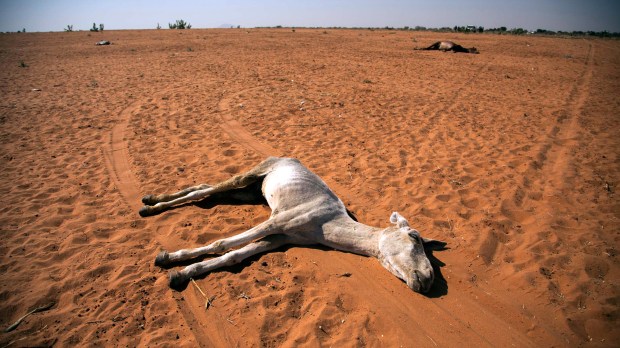With malnutrition growing and livestock dying, Ethiopians are praying that forecasts for rain prove true this year.
The El Nino weather system that struck Ethiopia last year left the East African country with no rain in either its spring or summer growing seasons. Subsequent crop failures left people scrambling for food and farmers without seed to plant. Families have been forced to take their children out of school so they can walk further to fetch water or find other ways to earn money.
The northern provinces of Tigray and Afar are the worst affected areas, said Mark Banga, a lay missionary with Comboni Lay Mission Program. Even in the south, though conditions are reasonable, the last rainy season was below average.
International Orthodox Christian Charities reports widespread crop failure and the death of livestock.
“I spoke to one man who said the whole village where he lives might move to another location,” said Seifu Tirfie, Ethiopia Country Representative for IOCC. “He’s not in a nomadic place. They just can’t wait. Everything is dry. He said, ‘We don’t have anything for our cows. We can buy feed for them, but we’ll finish all our savings. We just won’t sit by and watch our animals die.'”
“In a country where 85 percent of the population depend on rain-fed agriculture, when it doesn’t rain it’s a difficult time,” said Matt Davis, Catholic Relief Services’ country representative in Addis Ababa. “You see farmers losing their assets, [selling] off the few things that they have. … You see the effects of water tables in communities, where you see women and girls having to walk much further to find water for basic domestic use. You see families not having the ability to send kids to school because they’re out looking for water or other sustenance, so education is put aside.”
He said the El Nino particularly affected highland Ethiopia, which normally has more productive agricultural zones and higher populations. “And the higher air temperatures meant the soil became very dry last year and unproductive throughout large swaths of the country,” Davis explained.
By January of this year, more than 10 million people — 10 percent of the population — needed food assistance, he said.
Abba Gebre Yohannes runs a Catholic college and trade school, as well as a parish, in Wukro, in Ethiopia’s northernmost region of Tigray. The drought meant no harvest last year in many of the villages from which students come. Parents could not pay tuition, and the students had to find jobs to support their families. So out of about 750 students, only 586 remain.
Historically, an El Nino is followed by a year of normal rain patterns, and climatologists are saying this coming year should be normal, Davis said. “But most of Ethiopia won’t receive a harvest until September, so the relief effort will have to be maintained at least until then.
International charities are facing a challenge, however, as the situation is not bad enough to draw the attention of the media.
“We’re not on the radar. Largely, it’s the Middle East, Syria and the outflow of refugees to Europe that has been the attention grabber,” Davis said. “Because our systems and operations are much stronger than they used to be, we’re not seeing [starving children] on CNN, which is very good, but it’s a communications challenge to get out there to let people know there are some real needs in Ethiopia this year because of climactic forces, which have put a big strain on the country.”
The drought, he said, has not led to a famine, such as the one that devastated the country in the mid-1980s.
“This is not 1984 all over again,” Davis said. “The circumstances are similar, but the Ethiopian government has really stepped up and taken the lead on the relief operations. The infrastructure of the country is really a lot better than it was in the ’80s, and the international community — organizations like CRS, the United Nations and local civil society, the Church — are much stronger than it was in the ’80s and are able to provide basic services required for emergencies, as long as necessary funding comes into play this year.”
CRS is leading a US-funded consortium of relief agencies and the local church that is one of three food commodity pipelines into the country for relief. The other two are the government of Ethiopia and the World Food Program. The CRS-led consortium is feeding 2.6 million people.
The country is largely Orthodox, and Catholics are a minority, but the Catholic Church is the second-largest service provider after the government, in the areas of education and health. “Also in relief and development sector, the Catholic Church has a strong social service network set up here, a lot of strong infrastructure in various vicariates.”
For example, the Church has five drill rigs in various parts of the country and is “punching new wells and digging existing wells deeper,” Davis said.
While waiting and praying for rain, CRS is designing programs to get seed to farmers in a timely manner, “so they can prepare their land but then have something to plant when the rains come later this year.”
In the meantime, challenges are great. “I have been a missionary in Ethiopia for almost 10 years and this is the first time the country is dying of thirst,” Father Christopher Hartley told the Vatican’s Fides news agency. “As a result of the drought, there are many tribal struggles for access to the few remaining sources of water for people and livestock, while the crops are irreversibly disappearing, transforming this enormous landscape in a vast desert.”
John Burger is news editor for Aleteia’s English edition.

